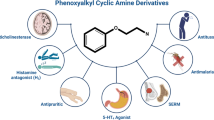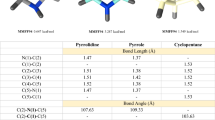Abstract
Isoindolines are the focus of much research because of being an important family of compounds present in a wide array of bioactive molecules. Although many different pathways of synthesis have been described, they do not follow green chemistry principles. The aim of this contribution was to develop a green synthesis technique for isoindolines/dioxoisoindolines. These compounds derived from analogs of important biogenic amines were tested in silico (on the human dopamine receptor D2) to predict their affinities and some pharmacokinetic parameters. One of them, YaI-01, was evaluated in vivo in a Parkinsonism mouse model. Seven molecules, including three isoindolines and four dioxoisoindolines, were synthesized using simple heating and relatively quick solventless reactions. They were then purified with a methodology as green as possible. Since no published crystal structure exists for dopamine receptor D2, it was necessary to generate and validate a homology model for molecular docking studies of the seven molecules synthesized presently. Docking was performed to assess affinity in terms of binding energy (∆G). Apart from pharmacokinetic parameters, Lipinski’s rule of five and some properties of toxicity from QSAR models were evaluated. Whereas no risk was found for the isoindolines, there was evidence of three kinds of toxicity for the isoindoline-1,3-dione compounds. Overall, the in silico analysis suggests that the three isoindolines herein tested have the best properties as ligands of the dopamine receptor D2, interacting with the main amino acid residues at its allosteric binding site. YaI-01 (254 µmol/kg) reverted Parkinsonism induced by 1-methyl-4-phenyl-1,2,3,6-tetrahydropyridine.



Similar content being viewed by others
References
Abdei-hafez AA (2004) Synthesis and anticonvulsant evaluation of N-substituted-isoindolinedione derivatives. Arch Pharm Res 27:495–501
Aliabadi A, Foroumadi A, Mohammadi-Farani A, Garmsiri Mahvar M (2013) Synthesis and evaluation of Anti-acetylcholinesterase activity of 2-(2-(4-(2-Oxo-2-phenylethyl)piperazin-1-yl) ethyl)Isoindoline-1,3-dione derivatives with potential anti-alzheimer effects. Iran J Basic Med Sci 16:1049–1054
Al-Qaisi JA, Alhussainy TM, Qinna NA et al. (2014) Synthesis and pharmacological evaluation of aminoacetylenic isoindoline-1,3-dione derivatives as anti-inflammatory agents. Arab J Chem 7:1024–1030
Bahena-Trujillo R, Flores G, Arias-Montaño JA (2000) Dopamina : síntesis, liberación y receptores en el Sistema Nervioso Central. Rev Bioméd 11:39–60
Buttinoni A, Tommasini R (1981) Preclinical studies on indoprofen, a new non-steroidal analgesic-antiinflammatory agent. Eur J Rheumatol Inflamm 4:3–10
Caine SB, Negus SS, Mello NK et al. (2002) Role of dopamine D2-like receptors in cocaine self-administration: studies with D2 receptor mutant mice and novel D2 receptor antagonists. J Neurosci 22:2977–2988
Chien EYT, Liu W, Zhao Q et al. (2011) Structure of the human dopamine D3 receptor in complex with a D2/D3 selective antagonist. Science 330:1091–1095
Dal Toso R, Sommer B, Ewert M et al. (1989) The dopamine D2 receptor: two molecular forms generated by alternative splicing. EMBO J 8:4025–4034
Farfán-García ED, Pérez-Rodríguez M, Espinosa-García C et al. (2016) Disruption of motor behavior and injury to the CNS induced by 3-thienylboronic acid in mice. Toxicol Appl Pharmacol 307:130–137
Forli S, Huey R, Pique ME et al. (2016) Computational protein-ligand docking and virtual drug screening with the AutoDock suite. Nat Protoc 11:905–919
Frisch MJ, Trucks GW, Schlegel HB, et al. (2016) Gaussian 09, Revision A.02; Gaussian, Inc.: Wallingford, CT, USA
Guatteo E, Yee A, McKearney J et al. (2013) Dual effects of L-DOPA on nigral dopaminergic neurons. Exp Neurol 247:582–594
Humphrey W, Dalke A, Schulten K (1996) VMD: visual molecular dynamics. J Mol Graph 14:33–38
Jindal DP, Singh B, Coumar MS et al. (2005) Synthesis of 4-(1-oxo-isoindoline) and 4-(5,6-dimethoxy-1-oxo-isoindoline)-substituted phenoxypropanolamines and their beta1-, beta2-adrenergic receptor binding studies. Bioorg Chem 33:310–324
Kato N, Oka M, Murase T et al. (2011) Synthesis and pharmacological characterization of potent, selective, and orally bioavailable isoindoline class dipeptidyl peptidase IV inhibitors. Org Med Chem Lett 1:7
Kitamura Y, Shimohama S, Akaike A, Taniguchi T (2000) The parkinsonian models: invertebrates to mammals. Jpn J Pharmacol 84:237–243
Kumar R, Riddle LR, Griffin SA et al. (2009) Evaluation of D2 and D3 dopamine receptor selective compounds on l-dopa-dependent abnormal involuntary movements in rats. Neuropharmacology 56:956–969
Lin JH, Yamazaki M (2003) Role of P-glycoprotein in pharmacokinetics: clinical implications. Clin Pharmacokinet 42:59–98
Lipinski CA, Lombardo F, Dominy BW, Feeney PJ (2001) Experimental and computational approaches to estimate solubility and permeability in drug discovery and development settings. Adv Drug Deliv Rev 46:3–26
Lovell SC, Davis IW, Arendall WB et al. (2003) Structure validation by Cα geometry: φ,ψ and Cβ deviation. Proteins 50:437–450
Lu Y, Peng Q, Zeng Z et al. (2014) CYP2D6 phenotypes and Parkinson’s disease risk: a meta-analysis. J Neurol Sci 336:161–168
Luedtke RR, Mishra Y, Wang Q et al. (2012) Comparison of the binding and functional properties of two structurally different D2 dopamine receptor subtype selective compounds. ACS Chem Neurosci 3:1050–1062
Mancilla T, Carrillo L, Zamudio-Rivera LS et al. (2001) Synthesis and characterization of new 2-substituted isoindoline derivatives of α-amino acids. Org Prep Proced Int 33:341–349
Mancilla T, Correa-Basurto J, Carbajal KSA et al. (2007) Theoretical study of isoindolines to identify them as cyclooxygenase-1 and -2 inhibitors by docking simulations. J Mex Chem Soc 51:96–102
Mancilla-Percino T, Correa-Basurto J, Trujillo-Ferrara J et al. (2010) Molecular modeling study of isoindolines as L-type Ca2+ channel blockers by docking calculations. J Mol Model 16:1377–1382
Mann A, Miksys SL, Gaedigk A et al. (2012) The neuroprotective enzyme CYP2D6 increases in the brain with age and is lower in Parkinson’s disease patients. Neurobiol Aging 33:2160–2171
Meredith GE, Sonsalla PK, Chesselet M-F (2008a) Animal models of Parkinson’s disease progression. Acta Neuropathol 115:385–398
Meredith GE, Totterdell S, Potashkin JA, Surmeier DJ (2008b) Modeling PD pathogenesis in mice: advantages of a chronic MPTP protocol. Parkinsonism Relat Disord 14(Suppl 2):S112–S115
Mohammadi-farani A, Ahmadi A, Nadri H, Aliabadi A (2013) Synthesis, docking and acetylcholinesterase inhibitory assessment of 2- (2- (4-Benzylpiperazin- potential anti-Alzheimer effects. DARU Journal of Pharmaceutical Sciences 21:1–10
Morris GM, Goodsell DS, Halliday RS et al. (1998) Automated docking using a Lamarckian genetic algorithm and an empirical binding free energy function. J Comput Chem 19:1639–1662
Morris GM, Ruth H, Lindstrom W et al. (2009) AutoDock4 and AutoDockTools4: automated docking with selective receptor flexibility. J Comput Chem 30:2785–2791
Percino TM, Basurto JC, Carbajal KSA et al. (2009) Molecular modeling study of 2-substituted isoindoline derivatives of α-amino acids as inhibitors of lipoxygenase by docking simulations. J Mex Chem Soc 53:1–6
Platania CBM, Salomone S, Leggio GM et al. (2012) Homology modeling of dopamine D2 and D3 receptors: molecular dynamics refinement and docking evaluation. PLoS One 7:1–12
Prasad KS, Kumar LS, Prasad M et al. (2010) Novel organotin(IV)-Schiff base complexes: synthesis, characterization, antimicrobial activity, and DNA interaction studies. Bioinorg Chem Appl 2010:1–9
Roy A, Kucukural A, Zhang Y (2010) I-TASSER: a unified platform for automated protein structure and function prediction. Nat Protoc 5:725–738
Sedelis M, Hofele K, Auburger GW et al. (2000) MPTP susceptibility in the mouse: behavioral, neurochemical, and histological analysis of gender and strain differences. Behav Genet 30:171–182
Shakir R, Muhi-Eldeen ZA, Matalka KZ, Qinna NA (2012) Analgesic and toxicity studies of aminoacetylenic isoindoline-1,3-dione derivatives. ISRN Pharmacol 2012:1–7
Soriano-Ursúa MA, Ocampo-López JO, Ocampo-Mendoza K et al. (2011) Theoretical study of 3-D molecular similarity and ligand binding modes of orthologous human and rat D2 dopamine receptors. Comput Biol Med 41:537–545
Subbarayappa A, Patoliya PU (2009) An efficient method for the synthesis of 2, 3-dihydro-1H-isoindoles. Indian Journal of Chemistry 48:545–552
Sukalovic V, Soskic V, Sencanski M et al. (2013) Determination of key receptor-ligand interactions of dopaminergic arylpiperazines and the dopamine D2 receptor homology model. J Mol Model 19:1751–1762
The UniProt Consortium (2015) UniProt: a hub for protein information. Nucleic Acids Res 43:D204–D212
Ullah F, Zang Q, Javed S et al. (2012) Synthesis of an isoindoline-annulated, tricyclic sultam library via microwave-assisted, continuous-flow organic synthesis (MACOS). Synthesis 44:2547–2554
Van Booven D, Marsh S, McLeod H et al. (2010) Cytochrome P450 2C9-CYP2C9. Pharmacogenet Genomics 20:277–281
Vangveravong S, McElveen E, Taylor M et al. (2006) Synthesis and characterization of selective dopamine D-2 receptor antagonists. Bioorg Med Chem 14:815–825
Wang B, Yang L-P, Zhang X-Z et al. (2009) New insights into the structural characteristics and functional relevance of the human cytochrome P450 2D6 enzyme. Drug Metab Rev 41:573–643
Wider C, Ross OA, Wszolek ZK (2010) Genetics of Parkinson disease and essential tremor. Curr Opin Neurol 23:388–393
Zang Q, Javed S, Porubsky P et al. (2012) Synthesis of a unique isoindoline/tetrahydroisoquinoline-based tricyclic sultam library utilizing a Heck-aza-Michael strategy. ACS Comb Sci 14:211–217
Zhao XZ, Maddali K, Marchand C et al. (2009) Diketoacid-genre HIV-1 integrase inhibitors containing enantiomeric arylamide functionality. Bioorg Med Chem 17:5318–5324
Acknowledgements
This work was supported by SIP of Instituto Politécnico Nacional, and CONACyT-México.
Author information
Authors and Affiliations
Corresponding author
Ethics declarations
Conflict of interest
The authors declare that they have no competing interests.
Electronic supplementary material
Rights and permissions
About this article
Cite this article
Andrade-Jorge, E., Bahena-Herrera, J.R., Garcia-Gamez, J. et al. Novel synthesis of isoindoline/isoindoline-1,3-dione derivatives under solventless conditions and evaluation with the human D2 receptor. Med Chem Res 26, 2420–2431 (2017). https://doi.org/10.1007/s00044-017-1942-6
Received:
Accepted:
Published:
Issue Date:
DOI: https://doi.org/10.1007/s00044-017-1942-6




